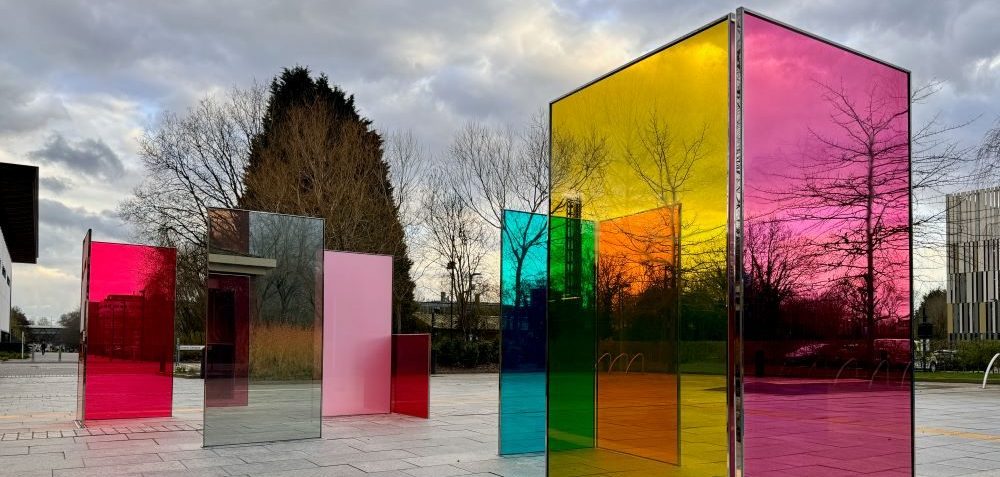Colour Connection: in conversation with Tine Bech, the artist behind Warwick’s newest sculpture
“I never really stopped loving colours. I love seeing people. I love them discovering the different elements of how you can experience the art.” This remark came from Tine Bech, on her new art piece ‘Colour Connection’, which has been installed in University House. An enthusiasm for creating eye-catching, interactive art can be seen throughout Bech’s work globally, and now, thankfully, it can be experienced at Warwick too. The Boar met with Bech earlier this month, on the day of the piece’s completion, to discuss Warwick’s newest addition to the sculpture park.
The challenges between managing to please officials, without stunting creativity, is a delicate game.
Sitting in University House, next to the site of the newly completed ‘Colour Connection’, it felt only appropriate to look back on the formative stages of Bech’s work. Bech first highlights the essential need for health and safety considerations, commenting that: “It’s an important part of making anything public, that everybody is safe. At the same time, there is also an element of bureaucracy around it.” It can only be assumed from Bech’s inflection that the challenges between managing to please officials, without stunting creativity, is a delicate game. This paradox adds to the openness in her work, with these potential limitations only seeming to engage Bech. Something tells me that the bureaucrats may meet their match as she remarks that, in art, “plain fact would have lots of things to say about risk, but that’s another story.”
Although, in the past Bech has found herself struggling with the demands of undertaking projects, finding that she “[had to keep] going for runs because [she] found it really hard to deal with.” At Warwick, it appears that working with Principal Art Curator, Sarah Shalgosky, has been a synchronous experience, from “meeting with the curator, meeting people, and meeting staff,” to exploring the campus extensively, gaining an understanding of where the piece could best join people together.
Bech clearly has a desire to bring community and connectivity to spaces across the globe.
A desire to bring people together is what drives Bech, throughout much of her work, from ‘BikeTag’, an art experience where colour was trailed through the city, to ‘Illuminated Swim’, seeing swimming pools transformed into spaces where people could swim through art. Bech clearly has a desire to bring community and connectivity to spaces across the globe. I joke to Bech that given the expansive ambition of her work, Antarctica might be her next worthy challenge. Yet, one could imagine Bech bringing connectivity to a barren icy desert, if it can be found in the once austere and corporate courtyard of University House. The joy of finding play in unexpected places, and bringing people into a world of connection and inclusion, fuels ‘Colour Connection’, as she comments: “you could do [something] on your own and enjoy it, but also do [it] with other people. That kind of core element of humans, social connections is what I want to create most of the time. If we have some colour and some beauty, that’s really good.”
The intent of ‘Colour Connection’ appears to be at play as Bech discusses how “happy [she was] to hear” how on “open days, the children play, and play, and play” and at the thrill of being called up to have onlookers ask: “Have you seen when it does this when the sun is shining?” However, this was not always the possible reality for the piece. The project’s completion is all the more satisfying knowing that the emanation of the project was pre-pandemic. Not having assurance that light would shine through, or if the art would be capable of facilitating interaction, feels severely amiss witnessing it now.
The piece can also be an emblem for gratitude.
Shalgosky informs me that misinterpretations of the project have formed already, being representative not of the relief post-pandemic, but of the panels representing the physical barriers enforced at the time. Bech comments that she “had no idea [that] someone would see it as barriers. But it’s true, we put up lots of glass and vinyls and things like that.” Bech combats this assumption, to say that “[she] sees it much more as a space to come together, as a space where if we look at the endemic context, we have to be outside, we discovered how public and shared spaces were actually really important.”
For Bech, the influence of the pandemic also highlighted the “inequality that’s linked to public space” as “we became more aware of the benefits of having shared public spaces.” In this, the piece can also be an emblem for gratitude, as Warwick students are fortunate enough to have these shared spaces where “invitation” is not necessary for us. A space where ‘Colour Connection’ is accessible.

Comments